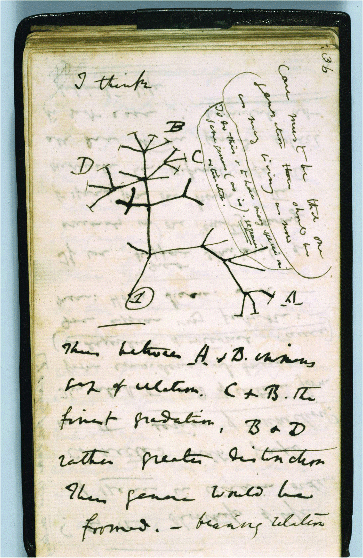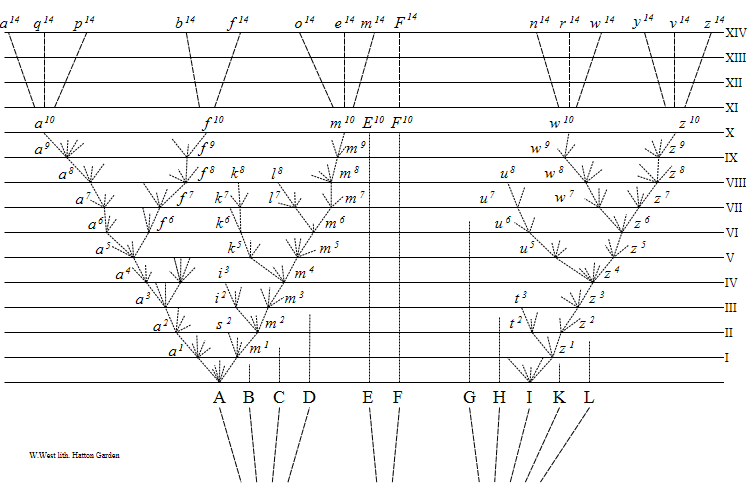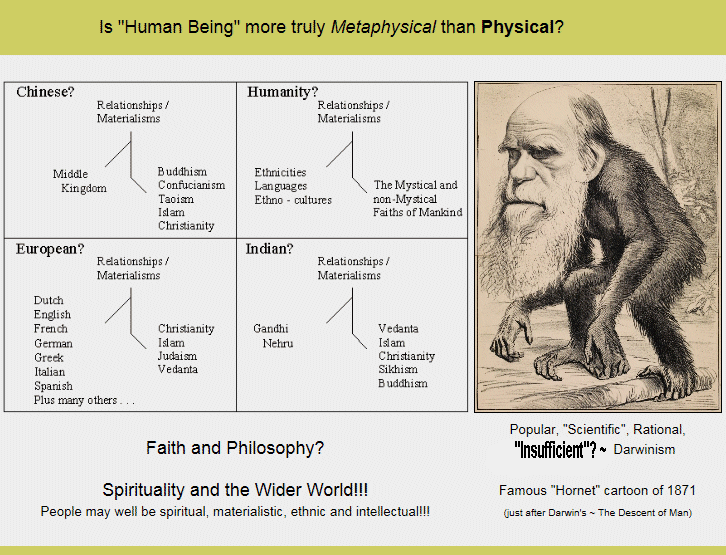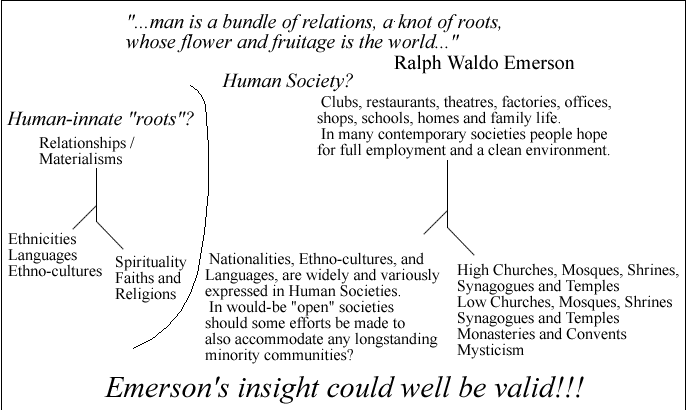Charles Darwin & the Tree of Life
A one-time theology student in training to become a minister of religion, albeit one with a passionate interest in natural history field studies, Darwin was informally recruited as a geological advisor to accompany british naval Captain Fitzroy on a surveying voyage to South America and the Pacific Ocean.
This voyage, on board HMS Beagle, lasted some five years from 1831 to 1836 and helped to transform the would-be country parson into a theologically skeptical man of science.
Darwin's Tree of Life sketch of 1837
(Some explanatory notes are presented further down this page with the aim of providing for an easier understanding of Darwin's concepts and for a fuller explanation of the terminolgy used.)
This sketch shows Charles Darwin's early theoretical insight of how a genus of related species might originate by divergence from a starting point (1).
The text annotations read:-
I think
Case must be that one generation then should be as many living as now. To do this & to have many species in same genus (as is) requires extinction.
Thus between A & B immense gap of relation. C & B the finest gradation, B & D rather greater distinction. Thus genera would be formed. - bearing relation to ancient types with several extinct forms...
From Darwin's Notebook B now stored in Cambridge University library.
Explanatory Notes
The number of surviving individuals would be limited by the food supply. Individuals drawn from an "original" species could be out-competed in terms of overall survivability by slightly variant individuals. Such variance would thereby be re-inforced and tend towards the emergence of one or more separate species. Where dramatically out-competed the original ancestor species could even be forced into extinction.
A related group of well-adapted variant species could, in time, constitute a new Genus of emergent species. The term Genera refers to a plurality of Genus(es).
Thus new Genera might "form" each composed of adapted specimens which had out-competed unadapted descendants of their common ancestors resulting in the original ancestor species coming under survival pressures and possibly even becoming extinct.

Whilst those involved in Natural History studies had initiated systems of classification where individual species which bore strong similarities to each other were "grouped" and regarded as being members of the same Genus, such grouping was based on observable close, and presumably "God ordained," similarities themselves rather than on an explicit acceptance of "biological" relatedness.
Darwin had, by 1837 and 1838, thought of the possible existence of processes leading to the extinction, and to the "formation", of species.
He only seems to have arrived at further insights that tended to give validity to such possible "species extinction", and such possible "species formation", many months after entering his early "Tree of Life sketch" into his notebooks.
"In October 1838, that is, fifteen months after I had begun my systematic enquiry, I happened to read for amusement Malthus on Population, and being well prepared to appreciate the
struggle for existence which everywhere goes on from long-continued observation of the habits of animals and plants, it at once struck me that under these circumstances favourable
variations would tend to be, preserved, and unfavourable ones to be destroyed. The result of this would be the formation of new species. Here, then, I had at last got a theory by
which to work; but I was so anxious to avoid prejudice, that I determined not for some time to write even the briefest sketch of it."
Charles Darwin
Charles Darwin
Such "struggle for existence" related theorisings were later explicitly expressed in Darwin's 'Origin of Species' of 1859.
"Owing to this struggle for life, any variation, however slight and from whatever cause proceeding, if it be in any degree profitable to an individual of any species, in its infinitely complex relations to other organic beings and to external nature, will tend to the preservation of that individual, and will generally be inherited by its offspring. The offspring, also, will thus have a better chance of surviving, for, of the many individuals of any species which are periodically born, but a small number can survive. I have called this principle, by which each slight variation, if useful, is preserved, by the term of Natural Selection, in order to mark its relation to man's power of selection."
- Charles Darwin, The Origin of Species
- Charles Darwin, The Origin of Species
The full title of Charles Darwin's book actually reads as :-
On the Origin of Species by Means of Natural Selection or the Preservation of Favoured Races in the Struggle for Life.
The Tree of Life sketch from
The Origin of Species of 1859
This diagram presented below, which is a significant updating of Charles Darwin's original Tree of
Life sketch of 1837, is the only illustration in the Origin of Species of 1859 and is referred extensively in Chapter IV., entitled Natural Selection, as an assistance
to the development of several key aspects of Darwin's theorising:-
… After the foregoing discussion, which ought to have been
much amplified, we may, I think, assume that the modified descendants of
any one species will succeed by so much the better as they become more
diversified in structure, and are thus enabled to encroach on places
occupied by other beings. Now let us see how this principle of great
benefit being derived from divergence of character, combined with the
principles of natural selection and of extinction, will tend to act. …
The Tree of Life diagram from Charles Darwin's seminal work~ The Origin of Species (1859) :-

The text of Chapter IV includes these excerpts:-
The accompanying diagram will aid us in understanding this
rather perplexing subject. Let A to L represent the species of a genus
large in its own country; these species are supposed to resemble each
other in unequal degrees, as is so generally the case in nature, and as is
represented in the diagram by the letters standing at unequal distances. …
… The intervals between the horizontal lines in the diagram, may represent each a thousand generations; but it would have been better if each had represented ten thousand generations. After a thousand generations, species (A) is supposed to have produced two fairly well-marked varieties, namely a1 and m1. …
…After ten thousand generations, species (A) is supposed to have produced three forms, a10, f10, and m10, which, from having diverged in character during the successive generations, will have come to differ largely, but perhaps unequally, from each other and from their common parent. If we suppose the amount of change between each horizontal line in our diagram to be excessively small, these three forms may still be only well-marked varieties; or they may have arrived at the doubtful category of sub-species; but we have only to suppose the steps in the process of modification to be more numerous or greater in amount, to convert these three forms into well-defined species: thus the diagram illustrates the steps by which the small differences distinguishing varieties are increased into the larger differences distinguishing species. …
…If then our diagram be assumed to represent a considerable amount of modification, species (A) and all the earlier varieties will have become extinct, having been replaced by eight new species (a14 to m14); and (I) will have been replaced by six (n14 to z14) new species. …
… The intervals between the horizontal lines in the diagram, may represent each a thousand generations; but it would have been better if each had represented ten thousand generations. After a thousand generations, species (A) is supposed to have produced two fairly well-marked varieties, namely a1 and m1. …
…After ten thousand generations, species (A) is supposed to have produced three forms, a10, f10, and m10, which, from having diverged in character during the successive generations, will have come to differ largely, but perhaps unequally, from each other and from their common parent. If we suppose the amount of change between each horizontal line in our diagram to be excessively small, these three forms may still be only well-marked varieties; or they may have arrived at the doubtful category of sub-species; but we have only to suppose the steps in the process of modification to be more numerous or greater in amount, to convert these three forms into well-defined species: thus the diagram illustrates the steps by which the small differences distinguishing varieties are increased into the larger differences distinguishing species. …
…If then our diagram be assumed to represent a considerable amount of modification, species (A) and all the earlier varieties will have become extinct, having been replaced by eight new species (a14 to m14); and (I) will have been replaced by six (n14 to z14) new species. …
Charles Darwin's explicit summary to
The Origin of Species, Chapter IV., "Natural Selection"
Chapter IV. is ended with an explicitly indicated chapter summary by Charles Darwin himself.
The final paragraph of this chapter summary reads:-
The affinities of all the beings of the same class have sometimes been represented by a great tree. I believe this simile largely speaks the truth. The green and budding twigs may represent existing species; and those produced during former years may represent the long succession of extinct species. At each period of growth all the growing twigs have tried to branch out on all sides, and to overtop and kill the surrounding twigs and branches, in the same manner as species and groups of species have at all times overmastered other species in the great battle for life. The limbs divided into great branches, and these into lesser and lesser branches, were themselves once, when the tree was young, budding twigs; and this connexion of the former and present buds by ramifying branches may well represent the classification of all extinct and living species in groups subordinate to groups. Of the many twigs which flourished when the tree was a mere bush, only two or three, now grown into great branches, yet survive and bear the other branches; so with the species which lived during long-past geological periods, very few have left living and modified descendants. From the first growth of the tree, many a limb and branch has decayed and dropped off; and these fallen branches of various sizes may represent those whole orders, families, and genera which have now no living representatives, and which are known to us only in a fossil state. As we here and there see a thin, straggling branch springing from a fork low down in a tree, and which by some chance has been favoured and is still alive on its summit, so we occasionally see an animal like the Ornithorhynchus or Lepidosiren, which in some small degree connects by its affinities two large branches of life, and which has apparently been saved from fatal competition by having inhabited a protected station. As buds give rise by growth to fresh buds, and these, if vigorous, branch out and overtop on all sides many a feebler branch, so by generation I believe it has been with the great Tree of Life, which fills with its dead and broken branches the crust of the earth, and covers the surface with its ever-branching and beautiful ramifications.

Darwinian Science and Metaphysics

"You will hear things like, 'Science doesn't know everything.' Well, of course science doesn't know everything. But,
because science doesn't know everything, it doesn't mean that science knows nothing. Science knows enough for us to be
watched by a few million people now on television, for these lights to be working, for quite extraordinary miracles to have taken
place in terms of the harnessing of the physical world and our dim approaches towards understanding it. And as Wittgenstein quite
rightly said, 'When we understand every single secret of the universe, there will still be left the eternal mystery of the human heart.'"
Stephen Fry quoting Wittgenstein during a Room 101 TV program of March 2001
There are two worlds, the microcosm, and the macrocosm, the internal and the external. We get truth from both of these by means of experience. The truth gathered from internal experience is psychology, metaphysics, and religion; from external experience, the physical sciences. Now a perfect truth should be in harmony with experiences in both these worlds. The microcosm must bear testimony to the macrocosm, and the macrocosm to the microcosm; physical truth must have its counterpart in the internal world, and the internal world must have its verification outside. Yet, as a rule, we find that many of these truths are in conflict. At one period of the world's history, the internals become supreme, and they begin to fight the externals. At the present time the externals, the physicists, have become supreme, and they have put down many claims of psychologists and metaphysicians.
Vivekananda
In Philosophy "Metaphysics" is the branch of Philosophy dealing with "being": how things exist, what things really are, what essence is, what it is 'to be' something, etc.
The word comes from a "book" of some thirteen treatises written by Aristotle which were traditionally arranged, by scholars who lived in the centuries after Aristotle's
life-time in the fourth century B.C., after those of his "books" which considered physics and natural science.Stephen Fry quoting Wittgenstein during a Room 101 TV program of March 2001
There are two worlds, the microcosm, and the macrocosm, the internal and the external. We get truth from both of these by means of experience. The truth gathered from internal experience is psychology, metaphysics, and religion; from external experience, the physical sciences. Now a perfect truth should be in harmony with experiences in both these worlds. The microcosm must bear testimony to the macrocosm, and the macrocosm to the microcosm; physical truth must have its counterpart in the internal world, and the internal world must have its verification outside. Yet, as a rule, we find that many of these truths are in conflict. At one period of the world's history, the internals become supreme, and they begin to fight the externals. At the present time the externals, the physicists, have become supreme, and they have put down many claims of psychologists and metaphysicians.
Vivekananda
It may be that for want of other terminology directly suited to reference such elusive subject matter the term MetaPhysica, (in Greek it means "after physics" or "beyond physics"), was adopted in relation to Aristotle's "book" of "metaphysical" treatises.
Aldous Huxley provided a few explicitly introductory pages in his 'The Perennial Philosophy'. This Introduction concludes with these words:-
"If one is not oneself a sage or saint, the best thing one can do, in the field of metaphysics, is to study the works of those who were, and who, because
they had modified their merely human mode of being, were capable of a more than merely human kind and amount of knowledge."

